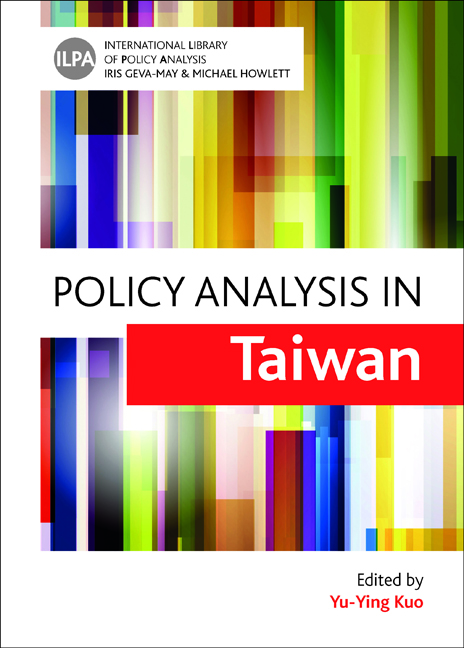Book contents
- Frontmatter
- Contents
- List of tables and figures
- Acknowledgements
- Notes on contributors
- One Policy analysis in a time of turbulence
- Two Exploring policy advisory committees in the central government
- Three Analysis of innovative local government policies in Taiwan
- Four Policy analysis in the legislative body: the legislative process of the Soil and Groundwater Pollution Remediation Act in Taiwan
- Five Policy analysis in the local councils
- Six Gendering policy analysis? The problems and pitfalls of participatory ‘gender impact assessment’
- Seven The power of influencing policies, or getting their share and more: interest groups in Taiwan
- Eight Think tanks in Taiwan
- Nine The development of public engagement in Taiwan
- Ten Social media and policy evolution in Taiwan
- Eleven Policy analysis by non-governmental organisations in Taiwan
- Twelve Policy network of universal healthcare reform in Taiwan
- Thirteen Public policy and administration research
- Fourteen Too critical to ignore? A tri-dimensional relationship examination of policy analysis internship in Taiwan
- Fifteen Policy analysis in Taiwan in an international perspective
- Sixteen Policy analysis education in Taiwan: a comparative perspective
- Index
Ten - Social media and policy evolution in Taiwan
Published online by Cambridge University Press: 11 March 2022
- Frontmatter
- Contents
- List of tables and figures
- Acknowledgements
- Notes on contributors
- One Policy analysis in a time of turbulence
- Two Exploring policy advisory committees in the central government
- Three Analysis of innovative local government policies in Taiwan
- Four Policy analysis in the legislative body: the legislative process of the Soil and Groundwater Pollution Remediation Act in Taiwan
- Five Policy analysis in the local councils
- Six Gendering policy analysis? The problems and pitfalls of participatory ‘gender impact assessment’
- Seven The power of influencing policies, or getting their share and more: interest groups in Taiwan
- Eight Think tanks in Taiwan
- Nine The development of public engagement in Taiwan
- Ten Social media and policy evolution in Taiwan
- Eleven Policy analysis by non-governmental organisations in Taiwan
- Twelve Policy network of universal healthcare reform in Taiwan
- Thirteen Public policy and administration research
- Fourteen Too critical to ignore? A tri-dimensional relationship examination of policy analysis internship in Taiwan
- Fifteen Policy analysis in Taiwan in an international perspective
- Sixteen Policy analysis education in Taiwan: a comparative perspective
- Index
Summary
Introduction
The rise and development of online technology in the last several years has reshaped politics and policy making in many ways (Leighninger, 2011: 20). In the United States, President Obama used social media applications such as Facebook, Twitter, MySpace, and YouTube during his presidential campaign in 2008 and 2012. In Arab countries, many activists who played crucial roles in the Arab Spring used social networking as a key tool in expressing their thoughts concerning unjust acts committed by governments. In Canada, economists use Twitter to engage with the public, journalists, politicians, and each other regarding their opinions of public policies (Jeff, 2011). These new forms of online communication and social networking tools are sometimes referred to as Web 2.0 (Anttiroiko, 2010: 18) or social media applications. Although the names (social media, social networking tools, Web 2.0, and so on) are different, they all refer to the use of web-based technologies to create highly interactive platforms through which individuals and communities share, cocreate, discuss, and modify user-generated content, such as Facebook, Twitter, blogs, and online forums. These applications offer numerous communication, information, and public relations benefits to individuals and organizations (Cain, 2011: 1036).
The interactive characteristic of social media allows governments and citizens to exchange information and ideas in a click at almost no cost. However, the government has to be alert to the impact of social media because these new, powerful communication tools are capable of influencing users’ opinions in the realms of politics and policy (Auer, 2011: 709). Nowadays, it is common for firsthand information to be released not in the traditional media but in private blogs, on Youtube or through other social media tools. For instance, during the 2004 Indian Ocean earthquake and tsunami, a Singapore resident, Rick Von Feldt, who witnessed the tsunami while holidaying on the beach in Phuket, Thailand created a blog detailing his survival experience. In Taiwan, an increasing number of drivers upload videos taped by their GPS devices of car accidents or robberies. When people use social media tools to share their own experiences using words or photos of public events such as disasters without any pre-screening, this sharing can possibly cause unexpected panic if the information contains personal bias or emotion.
- Type
- Chapter
- Information
- Policy Analysis in Taiwan , pp. 137 - 150Publisher: Bristol University PressPrint publication year: 2015



